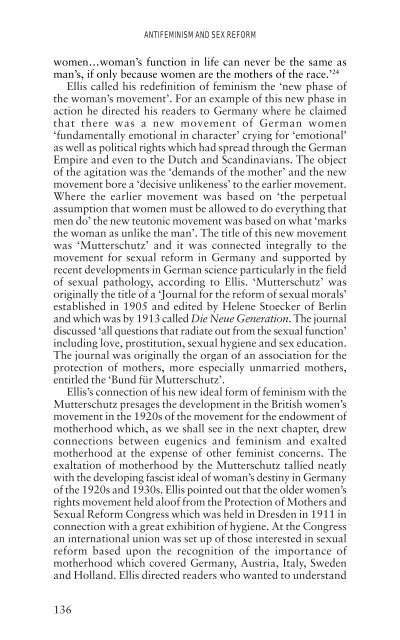The Spinster and Her Enemies - Feminish
The Spinster and Her Enemies - Feminish
The Spinster and Her Enemies - Feminish
You also want an ePaper? Increase the reach of your titles
YUMPU automatically turns print PDFs into web optimized ePapers that Google loves.
ANTIFEMINISM AND SEX REFORM<br />
women…woman’s function in life can never be the same as<br />
man’s, if only because women are the mothers of the race.’ 24<br />
Ellis called his redefinition of feminism the ‘new phase of<br />
the woman’s movement’. For an example of this new phase in<br />
action he directed his readers to Germany where he claimed<br />
that there was a new movement of German women<br />
‘fundamentally emotional in character’ crying for ‘emotional’<br />
as well as political rights which had spread through the German<br />
Empire <strong>and</strong> even to the Dutch <strong>and</strong> Sc<strong>and</strong>inavians. <strong>The</strong> object<br />
of the agitation was the ‘dem<strong>and</strong>s of the mother’ <strong>and</strong> the new<br />
movement bore a ‘decisive unlikeness’ to the earlier movement.<br />
Where the earlier movement was based on ‘the perpetual<br />
assumption that women must be allowed to do everything that<br />
men do’ the new teutonic movement was based on what ‘marks<br />
the woman as unlike the man’. <strong>The</strong> title of this new movement<br />
was ‘Mutterschutz’ <strong>and</strong> it was connected integrally to the<br />
movement for sexual reform in Germany <strong>and</strong> supported by<br />
recent developments in German science particularly in the field<br />
of sexual pathology, according to Ellis. ‘Mutterschutz’ was<br />
originally the title of a ‘Journal for the reform of sexual morals’<br />
established in 1905 <strong>and</strong> edited by Helene Stoecker of Berlin<br />
<strong>and</strong> which was by 1913 called Die Neue Generation. <strong>The</strong> journal<br />
discussed ‘all questions that radiate out from the sexual function’<br />
including love, prostitution, sexual hygiene <strong>and</strong> sex education.<br />
<strong>The</strong> journal was originally the organ of an association for the<br />
protection of mothers, more especially unmarried mothers,<br />
entitled the ‘Bund für Mutterschutz’.<br />
Ellis’s connection of his new ideal form of feminism with the<br />
Mutterschutz presages the development in the British women’s<br />
movement in the 1920s of the movement for the endowment of<br />
motherhood which, as we shall see in the next chapter, drew<br />
connections between eugenics <strong>and</strong> feminism <strong>and</strong> exalted<br />
motherhood at the expense of other feminist concerns. <strong>The</strong><br />
exaltation of motherhood by the Mutterschutz tallied neatly<br />
with the developing fascist ideal of woman’s destiny in Germany<br />
of the 1920s <strong>and</strong> 1930s. Ellis pointed out that the older women’s<br />
rights movement held aloof from the Protection of Mothers <strong>and</strong><br />
Sexual Reform Congress which was held in Dresden in 1911 in<br />
connection with a great exhibition of hygiene. At the Congress<br />
an international union was set up of those interested in sexual<br />
reform based upon the recognition of the importance of<br />
motherhood which covered Germany, Austria, Italy, Sweden<br />
<strong>and</strong> Holl<strong>and</strong>. Ellis directed readers who wanted to underst<strong>and</strong><br />
136

















